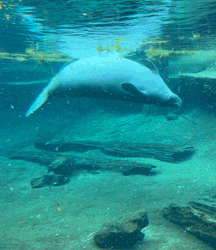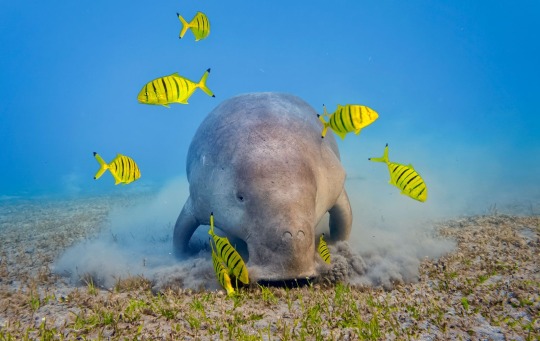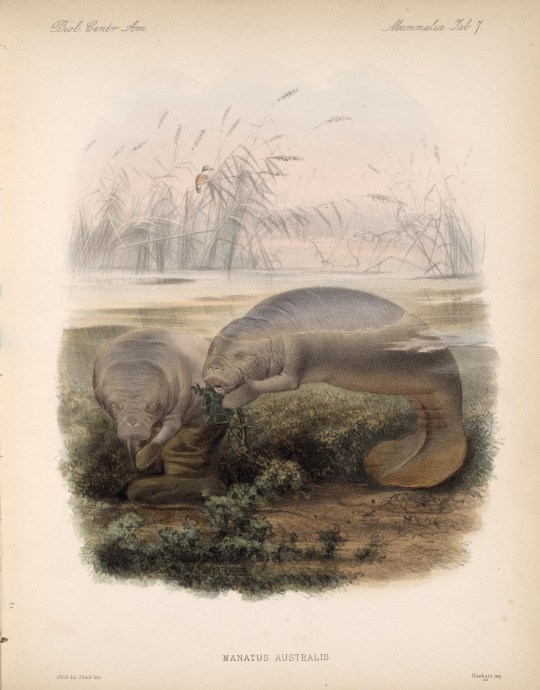#Sirenians
Explore tagged Tumblr posts
Text
For #WorldDugongDay:



Alick Tipoti (Torres Strait: Badhu Island, Kala Lagaw Ya, b.1975)
Kisay Dhangal, 2016
Sculpture, bronze with mother-of-pearl inlay
194 × 202 × 102 cm, 280 kg
Australian National Maritime Museum 00054952
"Inscribed with traditional motifs and pearl shell, Kisay Dhangal reflects the life cycle and feeding patterns of the dhangal (dugong) in the Torres Strait Islands. The dhangal is captured in the position known as San Tidayk, in Kala Lagaw Ya language which marks the moment the mammal flips its tail to dive down and graze on the sea grass beds. A marine dust trail between the tail and figure of the moon emphasize how lunar cycles determine dugong feeding and mating habits."
#Alick Tipoti#animals in art#animal holiday#sculpture#metalwork#bronze#Indigenous art#Australian art#Torres Strait Islander art#contemporary art#Australian National Maritime Museum#dugong#World Dugong Day#marine mammals#Sirenians#ethnozoology
167 notes
·
View notes
Text
obviously I can't include everything. Rip to the various groups I was forced to leave out, including Mesosaurs, my beloveds.
#tetrapods#marine reptiles#marine mammals#penguins#mosasaurs#plesiosaurs#cetaceans#sirenians#pinnipeds#desmostylians#thalattosuchians#dyrosaurids#pliosaurs#turtles
491 notes
·
View notes
Note
'pump them full of psychotropic drugs' is a new one for me (posted on a video of orphaned manatees being bottle fed)


That feeling when the psychotropic drugs kick in 😵💫 joking aside, it’s pretty pathetic that people still insist on believing this.
As for manatees, very, very few of them are permanently non-releasable, especially when compared with cetaceans. SeaWorld has great success releasing orphaned manatee calves, and most of their manatees on public display are orphans or other rescues getting nice and fat prior to release.
#I’ve actually been to their manatee icu#it’s pretty incredible#including the parts that aren’t offered as part of public tours#one of the patients at the time was a pregnant female who was released and gave birth to a healthy calf in the wild#manatees#sirenians#seaworld#wildlife rehab#ara insanity#answered asks#batplushies
102 notes
·
View notes
Text
World Dugong Day
Every year, on the 28th of May, it is celebrated the World Dugong Day! 🧜
Dugong is known as the sea cow (pic attached 🐮 - x). Why sea cow, you ask? These animals can be found in coastal environments feeding exclusively and extensively on seagrasses. The largest remaining population of Dugongs can be found in Australia (i), while the closest to the United Kingdom can be observed in the shallow waters of The Arabian Gulf (ii) 🌊
Why are dugongs important? 🧐
According to the Dugong & Seagrass Conservation Project (iii), dugongs contribute to maintaining balanced marine coastal environments, while also representing good indicators for local ecosystem health. Their presence is of course linked with seagrasses, which not only represents these herbivore mammals’ only source of food: seagrass sits at bottom of food chain in coastal environments (iv). Moreover, it provides important ecosystem services such as fish products, reduced erosion and flood protection (v). In other words, dugong presence is the manifestation of healthy ecosystem. Terrible news is: they are classified as vulnerable species (vi) 😰
Why are they declining? And how is climate change impacting their population? 😭
Dugongs are sensitive creatures not exempt from anthropogenic (modern age) disturbance. They have been largely hunted by humans for its meat, fat and oils, which caused significant population reduction (vi). Also, seagrass species are under extreme pressure due water quality variations largely driven by climate change (vii) and further human activity (viii). In addition, their slow reproduction rate and long life span (around 70 years) make them less resilient from not-environmentally friendly fishing practices (ix) 🎣
What can be done to support them? 💪
The Australian Great Barrier Reef and Marine Park Authority (i) provides the following recommendations:
1. Protect coastal habitats - Do not damage seagrass by dragging boats on underwater meadows and act against pollution, eutrophication and herbicide use deriving from land-based activities 🚜
2. Avoid use of mesh nets - Dugongs can get trapped in fishing nets 🥅
3. Boat responsibly - Dugongs are hard too spot while sitting on high speeding boats. Reduce speed while crossing shallow waters and seagrass meadows. If you spot one, it is likely it will not the only one in the area 🚢
4. Report - Just like for other sirenians, as well as cetaceans, it is essential to report injured/dead dugongs to local authorities ☎️
5. Donate - Dugong & Seagrass Conservation Project covers the conservation of dugongs and their associated seagrass ecosystems in eight countries in the Indo-Pacific region: Indonesia, Madagascar, Malaysia, Mozambique, Solomon Islands, Sri Lanka, Timor-Leste and Vanuatu. See more information here: https://www.dugongconservation.org/ 🙏
References:
i. https://www2.gbrmpa.gov.au/learn/animals/dugong#:~:text=Whether%20in%20protection%20areas%20or,flowing%20into%20creeks%20and%20rivers
ii. https://www.seaworldabudhabi.com/en/stories/meet-the-dugongs#:~:text=In%20the%20UAE%2C%20dugongs%20are,Marine%20Biosphere%20Reserve%20(MMBR)
iii. https://www.dugongconservation.org/about/about-dugongs-seagrass/
iv: https://education.nationalgeographic.org/resource/marine-food-chain/7th-grade/
v: https://www.ncbi.nlm.nih.gov/pmc/articles/PMC5061329/#:~:text=Seagrass%20ecosystems%20play%20a%20multi,erosion%20and%20protection%20against%20floods
vi: https://nc.iucnredlist.org/redlist/amazing-species/dugong-dugon/pdfs/original/dugong-dugon.pdf
vii: https://pubs.usgs.gov/publication/70204854#:~:text=A%20primary%20effect%20of%20increased,the%20patterns%20of%20sexual%20reproduction
viii: https://link.springer.com/chapter/10.1007/978-1-4020-2983-7_24#citeas
ix: https://www.dcceew.gov.au/sites/default/files/env/pages/0fcb6106-b4e3-4f9f-8d06-f6f94bea196b/files/north-report-card-dugong.pdf
x (picture): https://theconversation.com/dugongs-looking-to-the-gentle-sea-creatures-past-may-guard-its-future-122902

#dugongs#dugong#world dugong day#climate change#nature#sustainability#climate crisis#ecosystem#coastal#environment#environmental science#environmentalism#conservation#anthropocene#habitat#animals#sirens#sirenians
3 notes
·
View notes
Text

West African manatee Trichechus senegalensis
Observed by eniangii, CC BY-NC
168 notes
·
View notes
Text

By pgkaestner, CC BY-NC
52 notes
·
View notes
Text

Steller's sea cow - a recently extinct giant sirenian, related to modern dugongs and manatees. They went extinct in XVIII century, but their exctinction wasn't just because of europeans, we know that the last populations near Kamchatka were already on the brink of exctinction.

These huge animals could reach 9 metres in length and weight 10 tonnes, making them the largest aquatic non-cetacean mammal we know. They were algae eaters, feeding on kelp. Unlike modern sirenians, they didn't have teeth and used two keratin plates in their mouths for chewing. After feeding, according to Steller they'd lie on their backs and nap. Steller also observed an interesting mutualistic behaviour between sea cows and gulls (probably slaty-backed gulls), as these birds would eat parasites from the sea cow's back, like oxpeckers and rhinos.

The slaty-backed gull is one of the seabirds native to areas where sea cows used to live, and while we can't be sure which species of seabird fed on parasites of these large mammals, the opportunistic nature of seagulls makes them good contenders for the spot.

Despite their appearance, sea cows weren't stupid animals, they lived in large herds, looked after their young and were probably monogamous. Steller observed that they kept their calves in the middle of the herd or near the shore. This could have been caused by their predators.

Killer whales, specifically Bigg's killer whales, which are known to hunt other mammals, are the most likely predators of Steller's sea cow, apart from humans. While they might have trouble killing a large cow, especially in a herd, a small calf might be a meal worth the risk.

#3d#steller's sea cow#sirenian#sea cow#killer whale#orca#seagull#blender#lowpoly#paleoart#paleontology#nature#animals
148 notes
·
View notes
Text

The funny thing here is that most types of sea cows actually had tusks, except they were lost in modern manatees (which really are just a minor offshoot of sirenian) and covered by the lips in living animals. It becomes a lot more visible in skulls tho. Here shown in a figure by Velez-Juarbe, Domning & Pyenson and a skull photo of a modern dugong by Ji-Elle



Odobenocetops is a profoundly fucked up whale. The younger species, O. leptodon, had tusks way over a meter in length yet they were too fragile to be used for fighting or digging. The neck in both species was incredibly flexible as shown above O. peruvianus lacked a melon and couldn't echolocate, instead relying on binocular vision (O. leptodon had a small melon, which is better than nothing I guess) and they fed much like walrus, which means they would spit compressed water at the ocean floor to uncover shellfish, grab them with their lips and use their mouth as a vacuum pump to suck out all the soft parts only oh yeah and some speculate that it might have had whiskers covering its face
1K notes
·
View notes
Text
the setting with twist & the (non-sirenian) harpies is one i don't write in and doesn't really have much of a big story, similar to siren it has a bunch of small unrelated stories in various parts of the world but the major theme is cooperative relationships between regular humans and monsters. they have a common goal but also i wanted to explore different ways that cooperation could happen (willingly or not) and the various manifestations of human and monster relationships. sometimes antagonistic sometimes not. cuinn the harpy willingly chose to protect a human village; twist was trapped and forced to work. i've already drawn the work they do but i'll talk about it laterrr here's one of the harpy falconers anyway

#one thing u might notice about me is that my favourite theme is the almost-human. the thing that's not quite human or has transcended#humanity or exists only to mimic it. it's why i insist on calling the sirenians humans when lbr here... nobody truly thinks that.#in this setting all monsters have human or human-like faces due to some disaster/curse/whatever turning a subset of the population into#monsters generations ago. not that anyone knows this. siren who what never heard of it#ice storm over kosa
98 notes
·
View notes
Text
Happy #ManateeAppreciationDay!

1. Plate 7 in Biologia Centrali-Americana: Zoology, Botany and Archaeology, 1879-1915

2. Plate 37 in The Wild Beasts of the World, c.1909
Click here for more info on Manatee Appreciation Day!
#manatee#manatees#sirenians#marine mammals#mammals#natural history art#scientific illustration#sciart#book art#book plate#lithograph#19th century art#20th century art#British art#European art#Manatee Appreciation Day#animal holiday#animals in art
64 notes
·
View notes
Text

Today's Schleich is:
16086 Manatee [2002 - 2004]
32 notes
·
View notes
Note
yeah! it's not a horn, it's a tusk derived from the left canine tooth! sometimes the signalling that tells the horn to develop messes up, and both canines grow into horns, thus how you get double-tusked narwhals.
they're also SUPER WEIRD as teeth go! they're almost "inside out", with softer, highly-enervated material on the outside, and a dense core on the inside. this means they're incredibly sensitive, but afaik we still don't really know what they're Doing with that sensitivity
We know your stance on cows, but how do you feel about sea cows?

SEA COWS!!!!! I LOVE SEA COWS SO MUCH!!!!!!!!!!! AND NARWHALS !!!!!!
873 notes
·
View notes
Note
idk if you’d find this interesting but i think you might so i’ll share it. i hope it’s not bothering you! but i’ve learned a lot about cetacean captivity from following you and it’s made me interesting it getting other professional opinions on the matter. today i went to visit the sydney sea life aquarium in australia and the aquarists were patient enough to let me pick their brains a bit, specifically about the toki situation. interestingly enough, sealife’s parent company is explicitly anti cetacean captivity, enough so that they run a sea pen for two belugas in iceland that originally came from an aquarium that they acquired in shanghai. the marine biologist that let me bother her with my dumb questions is one of the trainers for their dugong so she has a fair bit of experience with marine mammals and she told me that her personal opinion is that toki doesn’t have the immune system for wild release and most likely isn’t going to survive a year. so a lot of the same stuff you’ve said. idk, i just thought it was interesting that even professionals who are generally anti cetacean cap (or who work for organizations that are) don’t think that it’s a good idea. sorry if you don’t really care or if this is obvious lol i just thought of you after talking with her :) as thanks for reading my long winded ask, here’s a picture of the dugong, pig, during a training session!

Hi Pig! What a cutie!
@local-hellhound-steals-spaghetti acutally used to work at this aquarium, so she can probably speak on it better than I can. I posted about the beluga sanctuary here, but basically, my opinions on SEA LIFE are *rolls eyes*. As far as aquariums go, they're fine. Their US locations are AZA accredited, but they're pretty middle-of-the-road in my opinion. I've only been to one location and wasn't overly impressed.
I also don't like the idea that fish are somehow less important and less deserving of exceptional welfare than more charismatic species like cetaceans. Sharks in particular need a lot of specialized care. But SEA LIFE is more than happy to put them in shopping malls (I don't know about the one you visited, but all their US locations are literally in malls) and publicly slander other far superior aquariums for housing cetaceans.
Of course, this is all directed at Merlin Entertainment managment, not the aquarists and trainers on the ground, who sound like they know their stuff!
#thank you for the ask! you’re definitely not bothering me ❤️#I’m sorry if my answer is a little off topic I mostly just wanted to take a dig at merlin#sea life#tokitae#aquariums#animal welfare#beluga whale sanctuary#dugong#sirenians#answered asks#fairylightfairlybright
24 notes
·
View notes
Text




Ceratosirenians and ceratocetaceans. More fictional chimerical panspermic marine wildlife field guide pseudo-illustration via Midjourney Niji 6.
#ai trash#sirenian dugong manatee hybrids#ceratopsian cetacean orca whale chimerae#panspermic extrasolar fauna#tapirverse nonsense
4 notes
·
View notes
Text

Dugong plushie
6 notes
·
View notes
Text
Sirenian Master Post
All posts relating to Sirenian will be linked here whether they are relevant or obsolete. If there is a post that you are looking for, search here first. If you can not find a link, the post does not or has not yet existed.
Introduction
Overview
Phonology
TBD
Morphology
TBD
Derivational Morphology
TBD
Syntax
TBD
Semantic Fields and Pragmatics
TBD
Sample Texts
TBD
Writing System
TBD
Lexicon
TBD
#Sirenian Updates#conlanging#language construction#language creation#glossopoeia#conlang#constructed language#fictional language#fantasy language#siren#sirencore#sirens#grammar#morphology#semantics#pragmatics#lexicon#phonology#derivation
3 notes
·
View notes